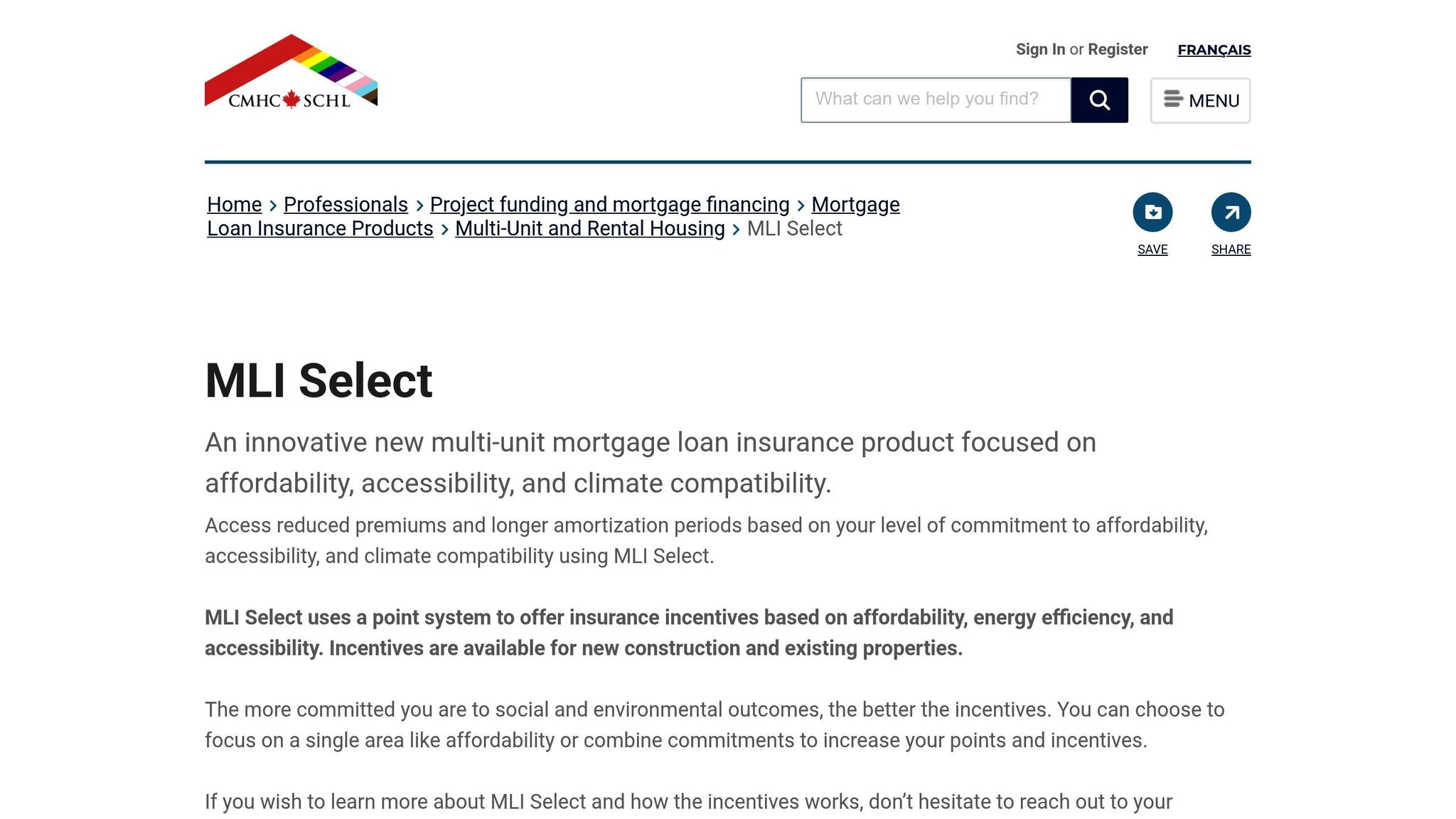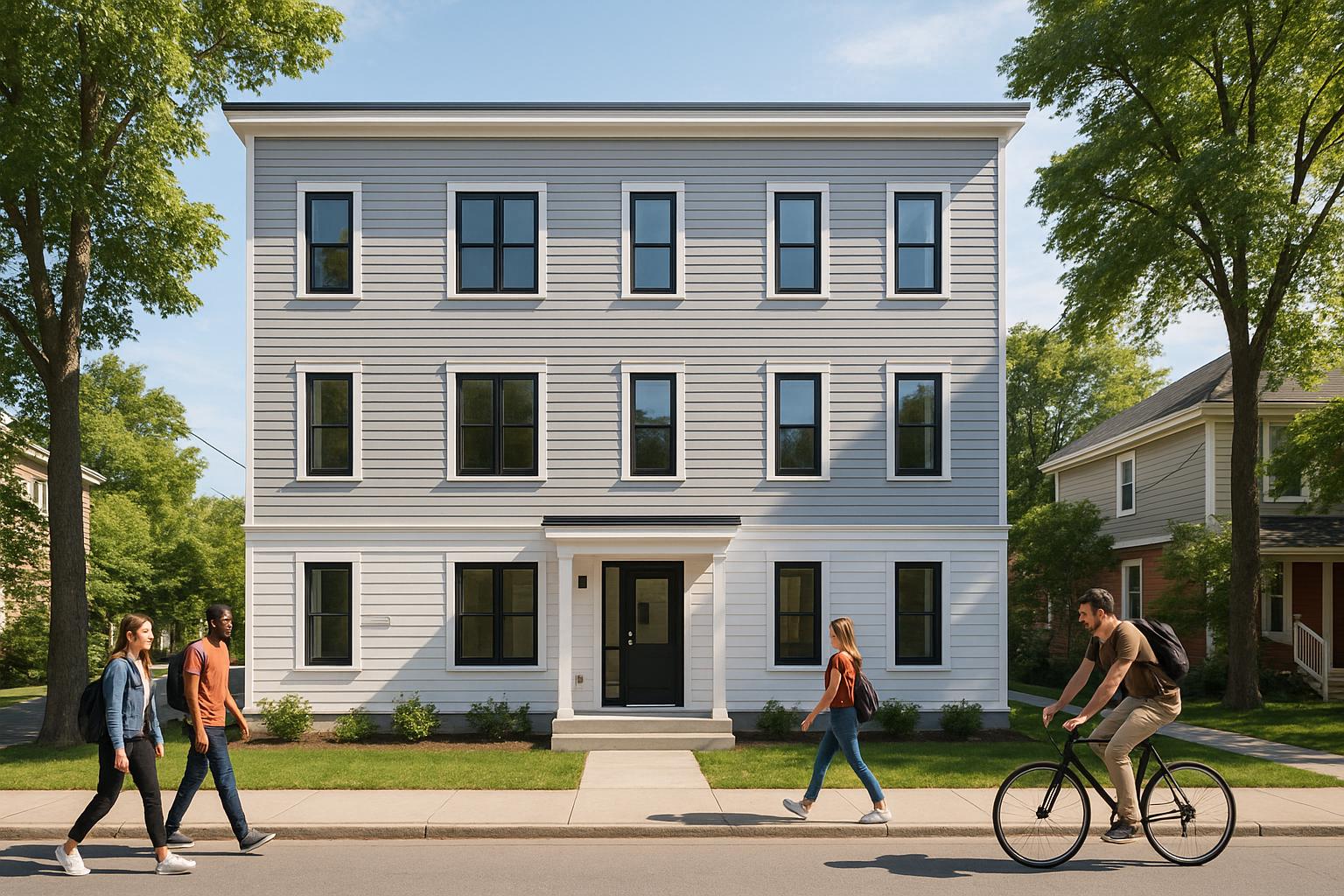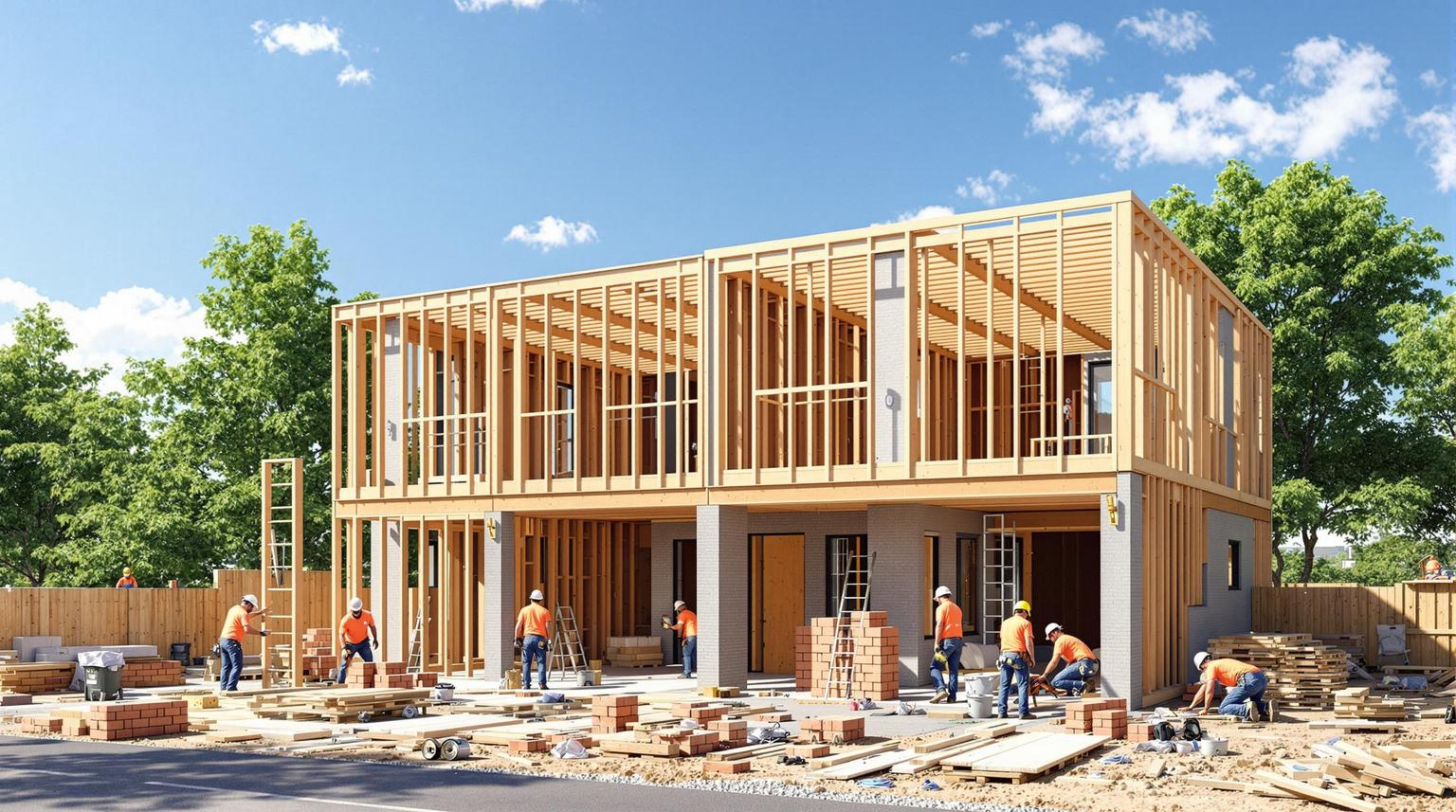Halifax is shifting how housing is developed to address a growing demand for 18,000 units now and 52,000 by 2027. The Centre Plan introduces ER-3 zoning, replacing most single-family R-1 zoning with rules that allow multi-unit housing like fourplexes and townhomes. These changes aim to increase housing density, especially along transit routes, while offering property owners more options to generate rental income. ER-3 permits up to eight-unit townhouses, fourplexes, and even ground-floor commercial spaces, making it easier to meet housing needs and diversify neighbourhoods. With reduced lot size requirements, no parking minimums, and access to favourable financing options like CMHC’s MLI Select program, Halifax is creating opportunities for property owners to build housing that fits today’s market demands.
What ER-3 Zoning Allows Property Owners to Build
ER-3 zoning opens up new possibilities for property development, going beyond the limitations of detached single-family homes. Unlike R-1 zoning, which restricts properties to single-family homes only, ER-3 allows for a wider range of housing options, making it an attractive choice for those looking to increase rental income. Below, we’ll explore the types of buildings permitted and the specific design rules that come with ER-3 zoning.
Building Types Allowed Under ER-3
With housing demand on the rise in Halifax, ER-3 zoning provides an opportunity to make better use of smaller lots. Under this zoning, property owners can construct four-unit dwellings, or fourplexes. This is a game-changer for those seeking to boost rental revenue, as a fourplex can potentially bring in four times the income of a single-family home on the same property.
In addition to fourplexes, ER-3 zoning permits townhouse developments with up to eight units in a row, doubling the limit of four units allowed under ER-2 zoning. Moreover, ER-3 includes all the development options available under ER-1 and ER-2, while introducing these expanded possibilities.
Another advantage is the allowance for ground-floor local commercial spaces and medical clinics, which adds diversity to income streams and supports mixed-use developments.
Building Requirements and Design Rules
ER-3 zoning balances increased development flexibility with the need to maintain harmony within neighbourhoods. The minimum lot area is 325 square metres, reduced from the R-1 standard of 371.6 square metres. This change increases the number of properties eligible for multi-unit development. Buildings can reach up to 11 metres in height, typically translating to three storeys, while lot coverage is capped at 40% (or 50% for lots larger than 325 square metres). These rules support higher density while preserving the character of the area.
For townhouse developments, the rules are even more accommodating. Interior townhouse units require 185 square metres of lot area with 6.1 metres of frontage, while end units need 245 square metres and 9.1 metres of frontage. This makes it possible to develop townhouses on lots that might otherwise be too small for multi-unit housing.
Setbacks and frontage requirements are also designed to encourage redevelopment. Side yard setbacks are set at 1.25 metres, rear yard setbacks at 6 metres, and the minimum lot frontage is reduced to 10.7 metres from the R-1 standard of 12.2 metres. These relaxed rules provide more options for property owners looking to redevelop their land.
R-1 vs ER-1/ER-2 vs ER-3 Zoning Comparison
Here’s a breakdown of how ER-3 zoning compares to other zoning types:
| Feature | R-1 (Previous) | ER-1 | ER-2 | ER-3 |
|---|---|---|---|---|
| Single-Unit Dwelling | Yes | Yes | Yes | Yes |
| Secondary Suite | No | Yes | Yes | Yes |
| Two-Unit Dwelling | Not permitted | Conditional | Yes | Yes |
| Three-Unit Dwelling | Not permitted | Conditional | Yes | Yes |
| Four-Unit Dwelling | No | No | No | Yes |
| Semi-Detached | No | No | Yes | Yes |
| Townhouse | No | No | Up to 4 units | Up to 8 units |
| Local Commercial | No | Corner lots only | No | Yes (ground floor only) |
| Medical Clinic | No | Corner lots only | No | Yes |
| Min. Lot Area | 371.6 sq. m | 325 sq. m | 325 sq. m | 325 sq. m |
| Max. Building Height | 10.7 m | 11 m | 11 m | 11 m |
| Max. Lot Coverage | 35% | 40–50% | 40–50% | 40–50% |
One of the standout features of ER-3 zoning is the ability to build four-unit dwellings. With Halifax rental rates averaging between $1,950 and $2,100 per unit, a fourplex could generate between $7,800 and $8,400 per month. This represents a significant increase in potential income compared to single-family rentals.
Overall, ER-3 zoning offers property owners more options and greater earning potential by accommodating a variety of residential and mixed-use developments. It’s a flexible framework that meets the growing demand for housing while allowing for creative and profitable property use.
How Property Owners Can Profit from ER-3 Zoning
Halifax’s ER-3 zoning now presents property owners with an opportunity to increase rental income by constructing multi-unit properties. With a strong demand for rentals and limited housing supply, these projects often deliver better returns than single-family homes.
Building Small Multi-Unit Properties
Constructing a fourplex on an existing lot can significantly increase rental income compared to a single-family home. This approach not only maximizes the use of the property but also sets the foundation for higher financial returns.
Financial Returns from ER-3 Development
Let’s break it down with an example: A property owner who invests $109,000 in a fourplex that generates $2,700 per unit (totalling $10,800 in monthly rent) could see an annual return of 8.07% after expenses[2].
Cap rates in Halifax range from 5.50% to 6.25%, with targets between 5% and 8% offering a balance of positive cash flow and manageable risk[2][3]. To fully understand the financial picture, property owners need to consider both gross rental income (total rent collected) and net rental income (gross income minus operating expenses). Typical property management fees, which usually fall between 6% and 10% of monthly rent, should also be factored in[3]. Achieving positive cash flow - where rental income covers mortgage payments, property taxes, insurance, and maintenance - is crucial to unlocking the full earning potential of the investment.
Financing Options and the CMHC MLI Select Program

The financial appeal of ER-3 projects is further amplified by attractive financing options. The CMHC MLI Select program offers tailored financing for these developments, using a points-based system that rewards commitments to affordability, energy efficiency, and accessibility[4].
Here’s how it works: Projects scoring at least 50 points qualify for up to 85% loan-to-value financing, with extended amortization periods of up to 40 years and a reduced debt service coverage ratio of 1.1x - much lower than the typical 1.25x requirement[4]. Higher scores unlock even better terms. For instance, projects earning 70+ points can access up to 95% financing with a 45-year amortization, while those hitting 100+ points can stretch amortization to 50 years[4].
These benefits can drastically reduce upfront costs. While traditional commercial mortgages often require down payments of 25–30%, the MLI Select program can lower this to as little as 5%, offering a leverage ratio of approximately 20:1. Additionally, the program includes premium discounts, ranging from 10% for 50-point projects to 30% for those scoring 100 points or more[5].
These favourable terms align with Halifax’s urban development goals and reduce initial financial barriers. Property owners are encouraged to work closely with MLI Select experts and specialized mortgage brokers to make the most of these opportunities[3].
Step-by-Step Guide to Building Under ER-3 Zoning
Building a multi-unit property under Halifax's ER-3 zoning requires careful planning and a methodical approach. This guide dives deeper into the process, breaking down each step to help property owners navigate the development journey effectively.
Development Process Steps for Property Owners
The first step is to confirm zoning. Start by verifying that your lot is zoned ER-3 and check for any special area regulations that may apply [1]. Since Halifax's zoning maps can change, it's always a good idea to consult directly with the municipality to ensure you're working with the latest information before committing to any investments.
Next, conduct a site assessment. This step involves determining if your lot meets the minimum requirements for your intended project. Pay attention to setbacks and the usable area of the lot. Under ER-3 zoning, you’re allowed up to 40% lot coverage [1]. For instance, if your property is 325 square metres, you can build a structure covering up to approximately 130 square metres.
Once the site is assessed, move on to plan design. Draft building plans that comply with ER-3 rules, including height restrictions. Structures cannot exceed 11 metres, though an additional 3 metres is permitted for pitched roofs or attics [6]. This typically accommodates designs ranging from 2.5 to 3 storeys, depending on your architectural choices.
The permitting phase comes next. Submit your plans to Halifax Regional Municipality for review and approval. The municipality ensures your project aligns with ER-3 regulations, including pedestrian-friendly and neighbourhood-compatible standards, before issuing the necessary building permits [6].
Finally, proceed to construction execution. Follow the approved plans and adhere to Halifax's building codes. One advantage of ER-3 zoning is the absence of minimum parking requirements, which can help reduce costs and free up valuable lot space for other uses [6].
Zoning Requirements and Design Rules
Adhering to ER-3 zoning rules is essential to ensure your project fits seamlessly into the neighbourhood.
Lot requirements vary depending on the type of building, but all projects must maintain front, side, and rear yard setbacks consistent with nearby homes. This approach helps preserve the existing character of the area. If your project involves multi-unit dwellings with five or more units, additional restrictions apply, such as a maximum building depth of 30 metres and a maximum width of 20 metres [6].
Design standards are also critical. Multi-unit developments must include proper garbage area screening, and all designs undergo review to ensure they complement the architectural style of the surrounding area [6]. These measures aim to minimize any negative impact on the neighbourhood's appearance and feel.
Another key feature of ER-3 zoning is the absence of parking minimums. Traditional zoning often requires one or two parking spaces per unit, which can take up a significant portion of the lot and increase construction costs. ER-3 eliminates this requirement, giving property owners more flexibility.
The building height limit of 11 metres, with an additional 3 metres allowed for pitched roofs, offers flexibility for various design approaches. For example, you could choose a flat roof to maximize interior space or a pitched roof to incorporate attic units, depending on your goals and the neighbourhood context.
Why Integrated Design-Build Works Better
When it comes to executing a project under ER-3 zoning, the traditional design-bid-build approach often leads to coordination challenges, delays, and cost overruns. This method involves separate contracts for architects, engineers, contractors, and other specialists, which can result in miscommunication and inefficiencies.
An integrated design-build approach simplifies the process by creating a single point of accountability. As Jaime Northam from Ryan Companies explains:
"A hands-on collaborative approach between the owner, design and construction teams from the start is critical. It creates a single point of accountability model and allows for the partners involved in the project to collaboratively conceptualize, design, and price the project while solving problems and timing concerns along the way, ultimately improving project quality and value." [7]
"A truly integrated design-build process, which involves collaboration from the beginning of the project concept, allows for a proactive approach to identifying and solving problems before they occur. This saves time, money, and the hassle of dealing with numerous change orders." [7]
This method also enables simultaneous work streams, allowing core construction to move forward while tenant improvements are finalized, which shortens overall timelines [7].
A unified design approach ties together site planning, architectural character, and environmental considerations, treating them as interconnected elements rather than separate tasks. This approach not only ensures smoother project execution but also helps maintain the integrity of established neighbourhoods while contributing to better community design [8].
sbb-itb-16b8a48
Common Problems in Multi-Unit Construction and How to Avoid Them
Building multi-unit properties under ER-3 zoning comes with its fair share of challenges. These hurdles can significantly impact your project’s success, but knowing what to expect - and how to handle it - can make all the difference between a profitable venture and a costly mistake.
Problems Property Owners Face in Multi-Unit Projects
Budget overruns are a frequent issue. Halifax's residential construction costs surged by 8.3% in 2023, driven by higher prices for materials, labour, and fuel [9]. For example, a fourplex budgeted at $640,000 can balloon to $900,000 due to poor coordination or unexpected change orders.
Timeline delays are another major concern. With a shortage of skilled trades, projects often face setbacks ranging from 8 to 18 months. These delays not only increase carrying costs but also push back rental income, straining finances further [9].
Coordination chaos often arises when multiple contractors work independently. Misaligned schedules and mismatched systems can lead to inefficiencies, driving up costs and prolonging timelines.
Financing complications have become more pronounced. With investment property mortgage rates hovering around 5–6% [9], lenders are increasingly cautious about financing smaller rental projects. This can tighten cash flows during construction and the lease-up phase.
Regulatory uncertainty adds another layer of complexity. Navigating Nova Scotia’s rent control policies, tenancy laws, and deed transfer tax can be challenging for property owners [9].
Quality control issues are common when several contractors handle different aspects of the build. Without a unified oversight structure, substandard work can slip through, ultimately affecting both property value and tenant satisfaction.
These challenges underscore the importance of adopting a unified and well-coordinated construction strategy.
Integrated Design-Build vs Traditional Construction
The key distinction between the integrated design-build model and traditional construction lies in how responsibilities and coordination are managed. Traditional methods separate design and construction into separate contracts, often leading to miscommunication and delays. On the other hand, the integrated approach brings all services under one contract, streamlining the entire process.
| Feature | Integrated Design-Build | Traditional Construction |
|---|---|---|
| Timeline | 33% faster completion [11] | Sequential phases cause delays |
| Cost Control | 6% less expensive on average [10] | Budget overruns are common |
| Accountability | Single point of responsibility | Divided among multiple parties |
| Communication | Internal coordination | Gaps between separate teams |
| Risk Management | Full project risk handled by one entity | Risk spread across contracts |
| Quality Control | Continuous oversight | Relies on coordination between teams |
The integrated model allows for overlapping design and construction phases, speeding up timelines and enabling quicker resolutions to feasibility or cost-related issues [11]. This approach not only simplifies risk management but also improves the chances of completing projects on time and within budget.
How to Get Quality Construction on Time and Budget
To achieve reliable results, property owners must tackle the root causes of common construction challenges with strategic solutions.
- Fixed-price contracts: These provide cost certainty by locking in the total price before work begins. This approach encourages accurate estimates and better planning.
- Guaranteed timelines with penalties: Some builders now include penalties - up to $1,000 per day - for late completion. This creates a strong incentive for timely delivery.
- Real-time budget tracking: Using construction management software to monitor costs daily can prevent minor overruns from spiralling out of control [14].
- Value engineering: During the design phase, this process identifies ways to save money without sacrificing quality. For example, it could involve using alternative materials, rethinking layouts, or incorporating prefabricated components [12].
- Supply chain management: Early procurement helps secure materials at better prices and avoids delays caused by shortages [12].
- Quality verification systems: Regular inspections by Professional Engineers, along with optional owner-appointed final checks, help maintain high standards throughout the project.
- Contingency planning: Setting aside 10–15% of the total budget as a contingency fund ensures unexpected costs don’t derail the project [13].
Ultimately, working with professionals who take a systematic, integrated approach to construction can help property owners navigate these challenges more effectively. By addressing common pitfalls with a design-build strategy, you can make the most of the opportunities offered by ER-3 zoning.
How to Make Money from ER-3 Zoning Changes
Halifax's transition from R-1 to ER-3 zoning has opened up exciting opportunities for property owners. According to staff estimates, these changes could add regulatory capacity for around 71,000 new units in the Regional Centre alone[15]. This increase in allowable density paves the way for multi-unit rental developments, offering significant income potential.
Under ER-3 zoning, property owners can build up to eight units per lot. Among the options, fourplexes strike a great balance between construction efficiency and rental income, making them an appealing choice for many investors.
The rental market in Halifax is thriving. Average rents are projected to reach $1,636 in 2024, reflecting a 6.4% jump from 2023. Investors in multifamily properties typically aim for returns in the 6–12% range, with construction costs averaging about $160,000 per unit[16][17].
Financing options have also become much more accessible. Programs like CMHC’s MLI Select now offer up to 95% financing with 50-year amortization periods. This drastically lowers the upfront investment needed. For instance, building a fourplex costing $800,000 might require just a 5% down payment, making it easier to get started.
Construction timelines have seen improvements, too. Projects that once took 12–18 months can now be completed in as little as six months, allowing property owners to start collecting rent and seeing returns much sooner.
Using an integrated design-build approach can make the process even smoother. Instead of juggling separate contracts for architects, engineers, and builders, you work with a single team that handles everything. This method ensures fixed pricing, guarantees timelines, and minimizes risks like budget overruns or delays.
Location is another key factor in maximizing profits. Properties in ER-3 zones near universities, hospitals, or transit corridors tend to attract higher rents and maintain strong occupancy rates, making them prime investment opportunities.
To make the most of ER-3 zoning, it’s crucial to avoid common mistakes. Partnering with builders who offer fixed-price contracts, guaranteed timelines, and stringent quality control can safeguard your investment. By focusing on these strategies - streamlined processes, smart location choices, and careful planning - you can not only boost your profits but also contribute to Halifax’s much-needed middle housing supply.
FAQs
How does the new ER-3 zoning impact the value and potential of my property compared to the old R-1 zoning?
The newly introduced ER-3 zoning in Halifax brings a significant boost to the potential value of your property when compared to the older R-1 zoning. While R-1 restricted properties to single-family homes, ER-3 allows for up to four units, including options like duplexes, triplexes, or townhomes. This expanded scope offers property owners more flexibility, paving the way for increased rental income and broader development opportunities.
With ER-3 zoning, properties often experience a jump in land value, thanks to their enhanced ability to generate income. This shift is especially advantageous in areas with high housing demand, enabling property owners to not only tap into greater financial returns but also play a role in easing housing shortages. These zoning updates open the door to exciting possibilities for future development and profitability.
What are the potential financial risks and rewards of developing a multi-unit property under ER-3 zoning in Halifax?
Developing a multi-unit property under Halifax's ER-3 zoning can open the door to some exciting financial possibilities. With the ability to build four or more units, property owners can significantly boost rental income while helping to meet the city's growing need for housing. Plus, the simplified approval process means fewer hurdles, making it easier to bring your project to life.
That said, there are some risks to keep in mind. Market demand can shift, rental rates might fluctuate, and future regulatory changes could affect occupancy and profitability. To navigate these challenges, thorough market research and strategic planning are crucial.
ER-3 zoning offers a chance to diversify your income while playing a role in addressing Halifax's housing needs. By approaching the opportunity with care and preparation, you can position yourself for success.
What steps can property owners take to successfully build under the new ER-3 zoning in Halifax?
To make the most of Halifax's new ER-3 zoning regulations, property owners should start by consulting with the city’s planning department. This step is crucial for understanding key zoning details like setbacks, lot coverage, and the maximum number of units allowed. Getting clarity upfront can prevent compliance issues and unexpected expenses later in the process.
Another smart move is to adopt a streamlined construction approach. Partnering with a builder who offers fixed-price contracts and takes full accountability can help keep costs in check, reduce delays, and simplify the overall project management. By combining thoughtful planning with the expertise of seasoned professionals, property owners can maximize the density opportunities provided by ER-3 zoning while steering clear of common construction challenges.



